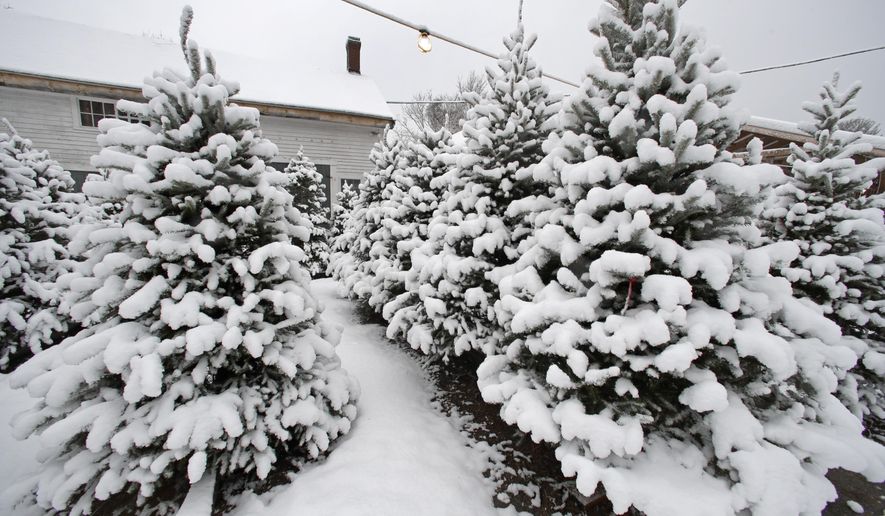Plan to pay more this year for a live Christmas tree, be it a compact Fraser fir from the Appalachians or a massive Nordmann fir that’s native to the Black Sea.
Inflation and droughts have increased tree prices by 5% to 20%, according to the American Christmas Tree Association.
The price of a Christmas tree averages $46 for a live sapling and $78 for an artificial replica, according to the association, a nonprofit group that provides information about the Christmas tree industry.
American Christmas Tree Association (ACTA) Executive Director Jami Warner has advice for lovers of authentic pine: Look for the best deals online.
Ms. Warner said that, while the cost of real trees has risen faster than last year, the price of artificial evergreens is about the same because suppliers purchased their stock in November 2021 before skyrocketing inflation hit the market.
“Last year, the supply chain crisis impacted every tree real and artificial,” Ms. Warner said. “This year, there’s no supply chain issue, but the impacts of drought coupled with inflation are killing live Christmas trees across the United States.”
SEE ALSO: Florida caterer being sued, accused of lacing wedding food with marijuana
Shoppers will find the best deals for real trees on farms and the worst increases at large retailers that require markups to cover rising labor and shipping costs, she added.
“Some of these inflationary increases have to be passed along to the customer, even though everyone from the grower to the retailer tries not to do that,” Ms. Warner said.
According to the association, of the 94 million U.S. households that display a tree each year, 15% exhibit live trees and 85% show off artificial ones.
North Star Christmas Trees owner Hugh Rodell says prices are up an average of 8% for the several thousand real trees on his lot. But most of the pricing increases are for premium and larger specimens, not for budget trees.
“We’re trying to keep Christmas trees affordable because everyone is feeling the crunch of this inflation,” said Mr. Rodell, whose company is based in Beltsville, Maryland. “I’m not passing along all of my price increases because a lot of consumers just don’t have much disposable income right now.”
In addition to rising costs for farm fertilizer and diesel fuel, Mr. Rodell says he’s paying 18% more for short-term truck rentals and 4-5% more for labor costs than a year ago.
“It’s almost everything. I don’t think there’s an expense that hasn’t gone up,” he said.
Over the summer, high temperatures and drought threatened thousands of young saplings on tree farms in some parts of the country.
But industry insiders say there has been a shortage of real trees for the past six years because growers planted fewer trees after the recession of 2008. It takes 5-15 years to grow a full Christmas tree to sell commercially.
“Growers couldn’t recoup their production costs and so planted fewer trees for several years,” said Jill Sidebottom, seasonal spokesperson for the National Christmas Tree Association, a trade group that represents thousands of tree growers and sellers.
Even with the market tightening this year, Ms. Sidebottom noted that a recent survey of the group’s tree growers found there should be enough real trees for everyone. The U.S. sells about 25 million to 30 million live trees a year, according to the industry group.
“Honestly, the cost of trees is just keeping up with inflation. What you paid for a tree in the late ’80s is essentially what you’re paying for a tree now,” she said.
Economists say rising labor costs have put the strongest pressure on Christmas tree production and transportation. Compensation costs for private industry workers increased by 5.2% from September 2021 to the same month this year, according to the Bureau of Labor Statistics.
“The labor market has been tight throughout all of 2022, and the competition for workers is likely to only increase during the holiday retail rush,” Samford (Alabama) University economist Joy Buchanan said.
Industry watchers say that could also limit the availability of artificial trees in some places due to pandemic lockdowns in China and small businesses reducing stock to offset rising prices. Discounts will be better for overstocked plastic trees in large retail stores.
“Prices this year are about flat to slightly down versus last year for artificial Christmas trees,” National Tree Co. CEO Chris Butler said. “We have seen heavy discounting as both retailers and manufacturers try to sell through inventory.”
National Tree Co., which is based in New Jersey, imports artificial trees.
The U.S. annually imports more than 90% of all artificial trees duty-free from China, according to the U.S. International Trade Commission’s DataWeb site, which provides trade and tariff statistics.
“The upshot for consumers this year is, if you want a particular type of tree, shop early. Else, you may have slim pickings,” said Christine McDaniel, a senior research fellow at George Mason University’s Mercatus Center free-market think tank and a former deputy assistant Treasury secretary.
• Sean Salai can be reached at ssalai@washingtontimes.com.




Please read our comment policy before commenting.